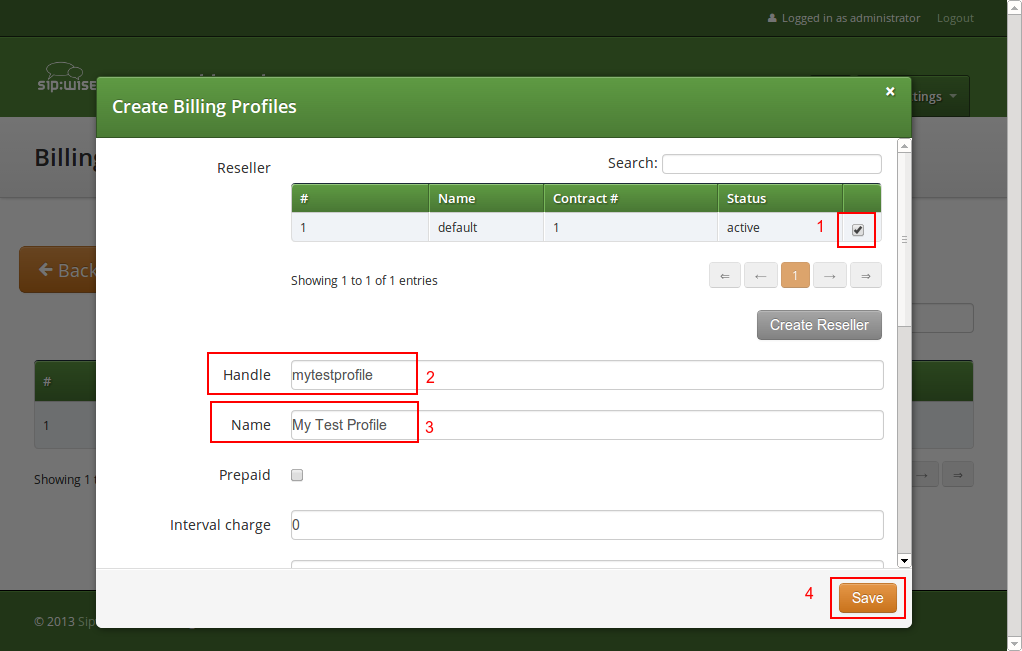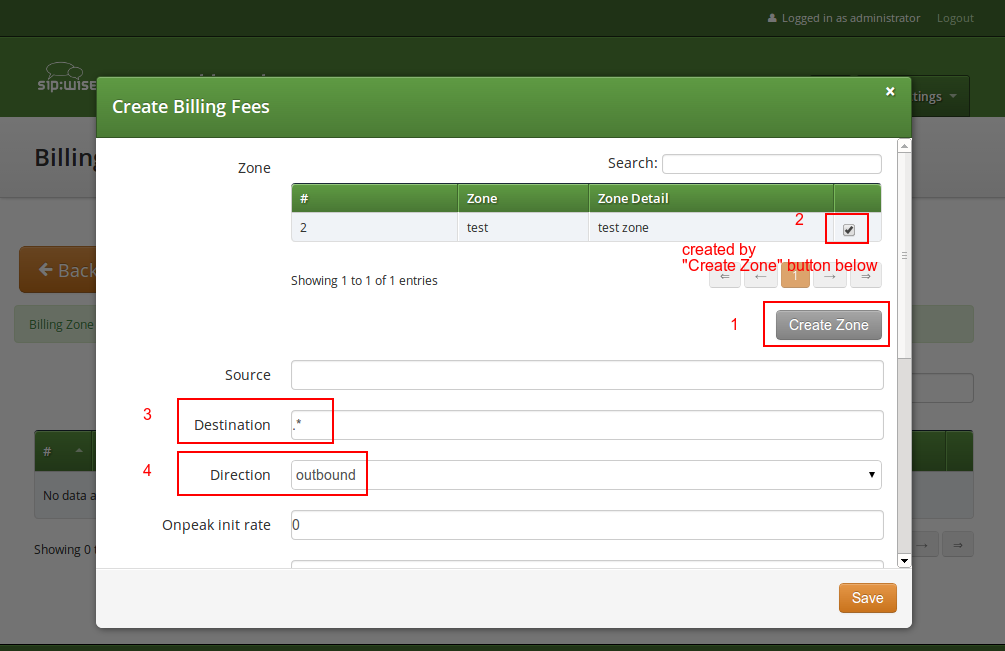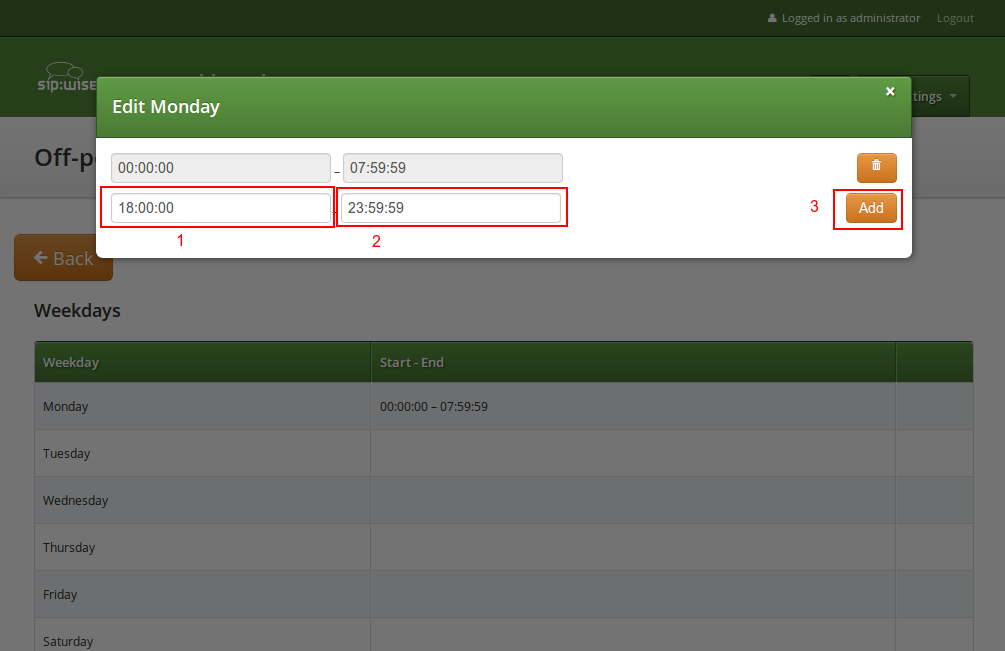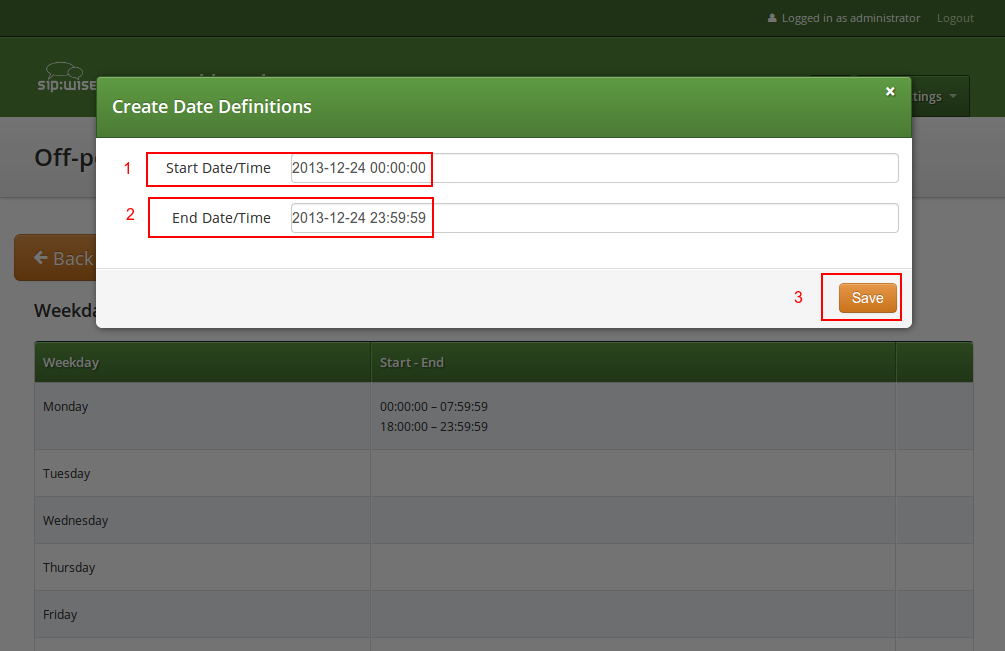| |
This chapter describes the steps necessary to rate calls and export rated CDRs (call detail records) to external systems.
Service billing on the NGCP is based on billing profiles, which may be assigned to VoIP accounts and SIP peerings. The design focuses on a simple, yet flexible approach, to support arbitrary dial-plans without introducing administrative overhead for the system administrators. The billing profiles may define a base fee and free time or free money per billing interval. Unused free time or money automatically expires at the end of the billing interval.
Each profile may have call destinations (usually based on E.164 number prefix matching) with configurable fees attached. Call destination fees each support individual intervals and rates, with a different duration and/or rate for the first interval. (e.g.: charge the first minute when the call is opened, then every 30 seconds, or make it independent of the duration at all) It is also possible to specify different durations and/or rates for peak and off-peak hours. Peak time may be specified based on weekdays, with additional support for manually managed dates based on calendar days. The call destinations can finally be grouped for an overview on user’s invoices by specifying a zone in two detail levels. (E.g.: national landline, national mobile, foreign 1, foreign 2, etc.)
The first step when setting up billing data is to create a billing profile, which will be the container for all other billing related data. Go to Settings→Billing and click on Create Billing Profile.

The fields Reseller, Handle and Name are mandatory.
Each Billing Profile holds multiple Billing Fees.
To set up billing fees, click on the Fees button of the billing profile you want to configure. Billing fees may be uploaded using a configurable CSV file format, or entered directly via the web interface by clicking Create Fee Entry. To configure the CSV field order for the file upload, rearrange the entries in the www_admin→fees_csv→element_order array in /etc/ngcp-config/config.yml and execute the command ngcpcfg apply. For input via the web interface, just fill in the text fields accordingly.

In both cases, the following information may be specified independently for every destination:
foreign zone 1)
^.*@sip\.example\.org$ or ^someone@sip\.sipwise\.com$ or just . to match everything). If you leave this field empty, the default pattern . matching everything will be set implicitly. Internally, this pattern will be matched against the <source_cli>@<source_domain> fields of the CDR.
someone@sip\.example\.org or ^43). This field must be set.
Outbound for standard origination fees (applies to callers placing a call and getting billed for that) or Inbound for termination fees (applies to callees if you want to charge them for receiving various calls, e.g. for 800-numbers). If in doubt, use Outbound. If you upload fees via CSV files, use out or in, respectively.
The {source, destination, direction} combination needs to be unique for a billing profile. The system will return an error if such a set is specified twice, both for the file upload and the input via the web interface. |
There are several internal services (vsc, conference, voicebox) which will need a specific destination entry with a domain-based destination. If you don’t want to charge the same (or nothing) for those services, add a fee for destination |
To be able to differentiate between on-peak and off-peak calls, the platform stores off-peak times for every billing profile based on weekdays and/or calendar days. To edit the settings for a billing profile, go to Settings→Billing and press the Peaktimes button on the billing profile you want to configure.
To set off-peak times for a weekday, click on Edit next to the according weekday. You will be presented with two input fields which both receive a timestamp in the form of hh:mm:ss specifying a time of day for the start and end of the off-peak period. If any of the fields is left empty, the system will automatically insert 00:00:00 (start field) or 23:59:59 (end field). Click on Add to store the setting in the database. You may create more than one off-peak period per weekday. To delete a range, just click Delete next to the entry. Click the close icon when done.

To specify off-peak ranges based on calendar dates, click on Create Special Off-Peak Date. Enter a date in the form of YYYY-MM-DD hh:mm:ss into the Start Date/Time input field and End Date/Time input field to define a range for the off-peak period.

The NGCP supports a fraud detection feature, which is designed to detect accounts causing unusually high customer costs, and then to perform one of several actions upon those accounts. This feature can be enabled and configured through two sets of billing profile options described in Section 9.1.1, “Creating Billing Profiles”, namely the monthly (fraud monthly limit, fraud monthly lock and fraud monthly notify) and daily limits (fraud daily limit, fraud daily lock and fraud daily notify). Either monthly/daily limits or both of them can be active at the same time.
Once a day, shortly after midnight local time, a background script automatically checks all accounts which are linked to a billing profile enabled for fraud detection, and selects those which have caused a higher cost than the fraud monthly limit configured in the billing profile, within the currently active billing interval (e.g. in the current month), or a higher cost than the fraud daily limit configured in the billing profile, within the calendar day. It then proceeds to perform at least one of the following actions on those accounts:
You can override these settings on a per-account basis via SOAP or the Admin interface. |
Accounts that were automatically locked by the fraud detection feature will not be automatically unlocked when the next billing interval starts. This has to be done manually through the administration panel or through the provisioning interface. |
If fraud detection is configured to only send an email and not lock the affected accounts, it will continue to do so for over-limit accounts every day. The accounts must either be locked in order to stop the emails (only currently active accounts are considered when the script looks for over-limit accounts) or some other action to resolve the conflict must be taken, such as disabling fraud detection for those accounts. |
Regular billing data export is done using CSV (comma separated values) files which may be downloaded from the platform using the cdrexport user which has been created during the installation.
In order to be able to easily identify billing files, the file name is constructed by the following fixed-length fields:
<prefix><separator><version><separator><timestamp><separator><sequence number><suffix>
The definition of the specific fields is as follows:
Table 2. CDR export file name format
| File name element | Length | Description |
|---|---|---|
| 7 | A fixed string. Always |
| 1 | A fixed character. Always |
| 3 | The format version, a three digit number. Currently |
| 14 | The file creation timestamp in the format |
| 10 | A unique 10-digit zero-padded sequence number for quick identification. |
| 4 | A fixed string. Always |
A valid example filename for a billing file created at 2012-03-10 14:30:00 and being the 42nd file exported by the system, is:
sipwise_007_20130310143000_0000000042.cdr
Each billing file consists of three parts: one header line, zero to 5000 body lines and one trailer line.
The billing file header is one single line, which is constructed by the following fields:
<version>,<number of records>
The definition of the specific fields is as follows:
Table 3. CDR export file header line format
| Body Element | Length | Type | Description |
|---|---|---|---|
| 3 | zero-padded uint | The format version. Currently |
| 4 | zero-padded uint | The number of body lines contained in the file. |
A valid example for a Header is:
007,0738
The body consists of a minimum of zero and a maximum of 5000 lines. Each line holds one call detail record in CSV format and is constructed by the following fields, all of them enclosed in single quotes:
Table 4. CDR export file body line format
| Body Element | Length | Type | Description |
|---|---|---|---|
| 1-10 | uint | Internal CDR id. |
| 19 | timestamp | Timestamp of last modification. |
| 36 | string | Internal UUID of calling party subscriber. |
| 1-255 | string | Internal ID of calling party provider. |
| 0-255 | string | External ID of calling party subscriber. |
| 1-10 | uint | Internal ID of calling party subscriber. |
| 0-255 | string | External ID of calling party VoIP account. |
| 1-10 | uint | Internal ID of calling party VoIP account. |
| 1-255 | string | SIP username of calling party. |
| 1-255 | string | SIP domain of calling party. |
| 1-64 | string | CLI of calling party in E.164 format. |
| 1 | uint |
|
| 0-64 | string | IP Address of the calling party. |
| 1 / 36 | string | Internal UUID of called party subscriber or |
| 1-255 | string | Internal ID of called party provider. |
| 0-255 | string | External ID of called party subscriber. |
| 1-10 | uint | Internal ID of called party subscriber. |
| 0-255 | string | External ID of called party VoIP account. |
| 1-10 | uint | Internal ID of called party VoIP account. |
| 1-255 | string | Final SIP username of called party. |
| 1-255 | string | Final SIP domain of called party. |
| 1-255 | string | Incoming SIP username of called party. |
| 1-255 | string | Incoming SIP domain of called party. |
| 1-255 | string | The user-part of the SIP Request URI as received by the soft-switch. |
| 0-255 | string | User to authenticate towards peer. |
| 0-255 | string | Realm to authenticate towards peer. |
| 3-4 | string | The type of the call - one of:
|
| 2-7 | string | The final call status - one of:
|
| 3 | uint | The final SIP status code. |
| 23 | timestamp | Timestamp of call initiation (invite received from caller). Seconds include fractional part (3 decimals). |
| 23 | timestamp | Timestamp of call establishment (final response received from callee). Seconds include fractional part (3 decimals). |
| 4-11 | fixed precision | Length of call (beginning at |
| 1-255 | string | The SIP call-id. |
| 2-7 | string | The internal rating status - one of:
Currently always |
| 0 / 19 | timestamp | Timestamp of rating or empty if not rated. |
| 4-11 | fixed precision | The originating carrier cost or empty if not rated. In cent with two decimals. |
| 4-11 | fixed precision | The originating customer cost or empty if not rated. In cent with two decimals. |
| 0-127 | string | The originating carrier billing zone or empty if not rated. |
| 0-127 | string | The originating customer billing zone or empty if not rated. |
| 0-127 | string | The originating carrier billing destination or empty if not rated. |
| 0-127 | string | The originating customer billing destination or empty if not rated. |
| 1-10 | uint | The number of originating free time seconds used on carrier side or empty if not rated. |
| 1-10 | uint | The number of originating free time seconds used from the customer’s account balance or empty if not rated. |
| 4-11 | fixed precision | The termination carrier cost or empty if not rated. In cent with two decimals. |
| 4-11 | fixed precision | The termination customer cost or empty if not rated. In cent with two decimals. |
| 0-127 | string | The termination carrier billing zone or empty if not rated. |
| 0-127 | string | The termination customer billing zone or empty if not rated. |
| 0-127 | string | The termination carrier billing destination or empty if not rated. |
| 0-127 | string | The termination customer billing destination or empty if not rated. |
| 1-10 | uint | The number of termination free time seconds used on carrier side or empty if not rated. |
| 1-10 | uint | The number of termination free time seconds used from the customer’s account balance or empty if not rated. |
| 4-11 | fixed precision | The originating reseller cost or empty if not rated. In cent with two decimals. |
| 0-127 | string | The originating reseller billing zone or empty if not rated. |
| 0-127 | string | The originating reseller billing destination or empty if not rated. |
| 1-10 | uint | The number of originating free time seconds used from the reseller’s account balance or empty if not rated. |
| 4-11 | fixed precision | The termination reseller cost or empty if not rated. In cent with two decimals. |
| 0-127 | string | The termination reseller billing zone or empty if not rated. |
| 0-127 | string | The termination reseller billing destination or empty if not rated. |
| 1-10 | uint | The number of termination free time seconds used from the reseller’s account balance or empty if not rated. |
| 1 | string | A fixed character. Always |
A valid example of one body line of a rated CDR is (line breaks added for clarity):
'15','2013-03-26 22:09:11','a84508a8-d256-4c80-a84e-820099a827b0','1','','1','', '2','testuser1','192.168.51.133','4311001','0','192.168.51.1', '94d85b63-8f4b-43f0-b3b0-221c9e3373f2','1','','3','','4','testuser3', '192.168.51.133','testuser3','192.168.51.133','testuser3','','','call','ok','200', '2013-03-25 20:24:50.890','2013-03-25 20:24:51.460','10.880','44449842', 'ok','2013-03-25 20:25:27','0.00','24.00','onnet','testzone','platform internal', 'testzone','0','0','0.00','200.00','','foo','','foo','0','0', '0.00','','','0','0.00','','','0'
The format of the CDR export files generated for resellers (as opposed to the complete system-wide export) is identical except for a few missing fields. Reseller CDR CSV files don’t contain the fields for carrier or reseller ratings, neither in source nor destination direction. Thus, the reseller CSV files have 16 fewer fields.
The billing file trailer is one single line, which is constructed by the following fields:
<md5 sum>
The <md5 sum> is a 32 character hexadecimal MD5 hash of the Header and Body.
To validate the billing file, one must remove the Trailer before computing the MD5 sum of the file. An example bash script to validate the integrity of the file is given below:
#!/bin/sh
error() { echo $@; exit 1; }
test -n "$1" || error "Usage: $0 <cdr-file>"
test -f "$1" || error "File '$1' not found"
TMPFILE="/tmp/$(basename "$1")"
MD5="$(sed -rn '$ s/^([a-z0-9]{32}).*$/\1/i p' "$1") $TMPFILE"
sed '$d' "$1" > "$TMPFILE"
echo "$MD5" | md5sum -c -
rm -f "$TMPFILE"Given the script is located in cdr-md5.sh and the CDR-file is sipwise_001_20071110123000_0000000004.cdr, the output of the integrity check for an intact CDR file would be:
$ ./cdr-md5.sh sipwise_001_20071110123000_0000000004.cdr /tmp/sipwise_001_20071110123000_0000000004.cdr: OK
If the file has been altered during transmission, the output of the integrity check would be:
$ ./cdr-md5.sh sipwise_001_20071110123000_0000000004.cdr /tmp/sipwise_001_20071110123000_0000000004.cdr: FAILED md5sum: WARNING: 1 of 1 computed checksum did NOT match
Billing files are created twice per hour at minutes 25 and 55 and are stored in the home directory of the cdrexport user. System exports containing all CDRs reside in system/, and Reseller exports reside in resellers/<reseller-name>. If the amount of records within the transmission interval exceeds the threshold of 5000 records per file, multiple billing files are created. If no billing records are found for an interval, a billing file without body data is constructed for easy detection of lost billing files on the 3rd party side.
CDR files are fetched by a 3rd party billing system using SFTP or SCP with either public key or password authentication using the username cdrexport.
If public key authentication is chosen, the public key file has to be stored in the file ~/.ssh/authorized_keys2 below the home directory of the cdrexport user. Otherwise, a password has to be set for the user.
The 3rd party billing system is responsible for deleting CDR files after fetching them.
The |